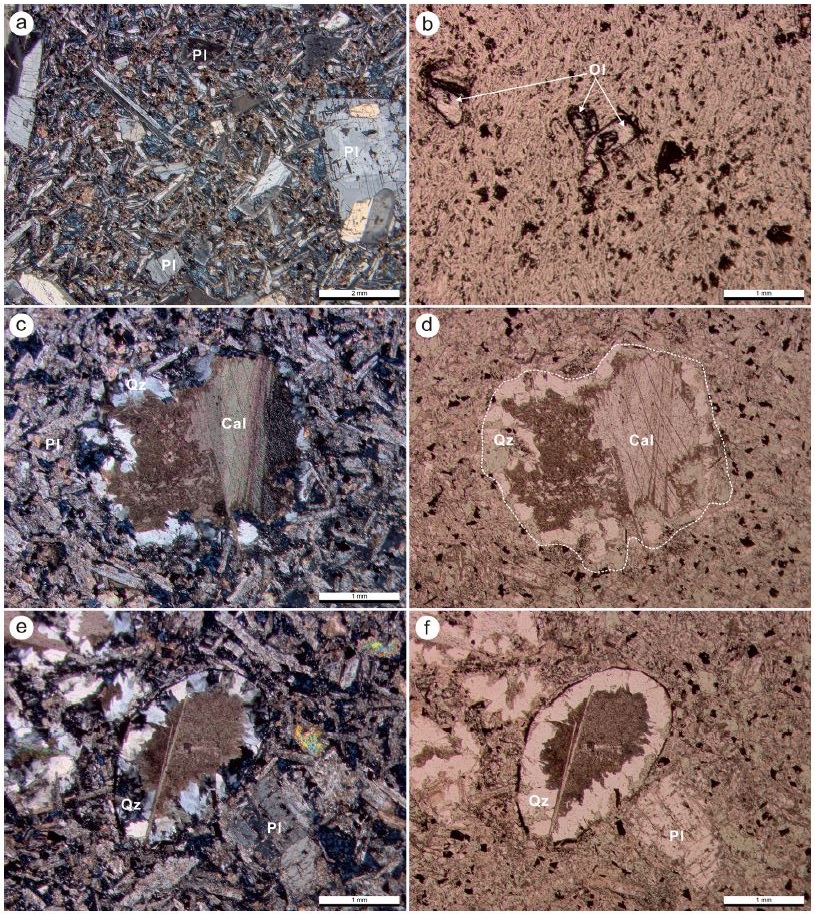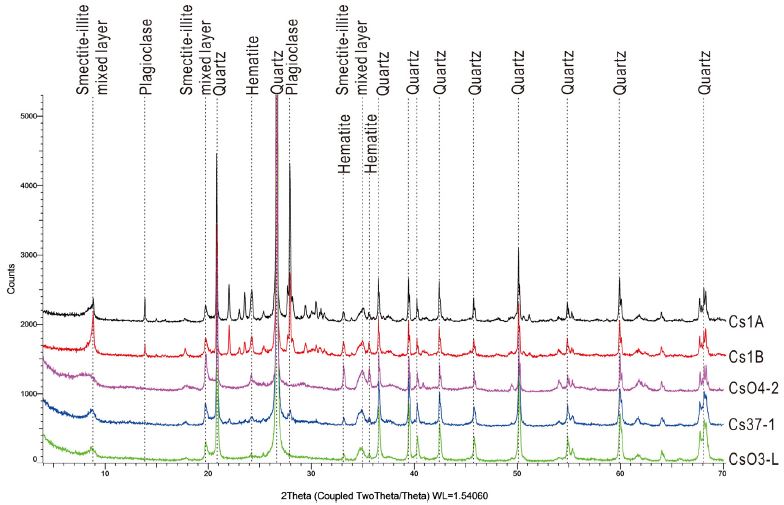
청송 유네스코 세계지질공원 내 주방천 페퍼라이트의 재고찰 : 수압파쇄에 의해 형성된 유사 페퍼라이트
초록
청송 유네스코 세계지질공원 지질명소 중 하나인 주방천 페퍼라이트는 현무암질 용암과 자색 퇴적물이 섞여 만들어진 조직으로 해석되었으며, 이 조직은 퇴적동시성 화산활동의 주요 사례로 지질교육에 활용되고 있다. 야외지질조사결과, 현무암은 하위의 퇴적암과 화산암을 자르고 있는 관입암으로 해석되며, 관입암 내의 페퍼라이트 조직은 두 암석의 경계부에 산출되는 일반적인 페퍼라이트 특징과 차이를 보이고 있다. SEM-EDS 분석 결과, 현무암편의 가장자리에 급냉대 또는 열변질 흔적이 없고 은미정질 석영과 점토광물로 구성된 자색의 퇴적물은 교란 흔적이 없는 특징을 보인다. 이는 페퍼라이트 형성 시 퇴적물이 유체작용에 의해 내부 층리가 파괴되고 마그마 기원의 암편 가장자리에 급냉대가 만들어지는 특징과 일치하지 않는다. 반면, 현무암편의 가장자리가 울퉁불퉁한 점 그리고 퇴적물 내부에 현무암편을 포함하고 있는 특징은 내부로 주입된 유체에 의해 현무암이 제자리에서 파쇄되고 그 사이를 유체에 운반되던 석영이 성장하여 채웠던 것으로 해석된다. 따라서 현무암 내의 자색 퇴적물은 이차적인 유체에 의해 만들어진 광맥으로 판단된다. 이는 주방천 페퍼라이트가 퇴적동시성 화성활동에 의해 형성된 것이 아닌 이차적인 수압파쇄에 의해 만들어진 유사 페퍼라이트(pesudo-peperite or peperite-like) 조직임을 시사한다.
Abstract
The Jubangcheon peperite, one of the geosites of the Cheongsong UNESCO Global Geopark, has been interpreted as a mixture of basaltic lava flow and wet sediments, and is used for geo-education as a unique example of synsedimentary volcanism. As a result of the field survey, the basalt cutting the underlying sedimentary and volcanic rocks is interpreted as intrusive rock, and the peperitic texture within the rock shows a difference from the typical peperite features at the boundaries between two rocks. As a result of SEM-EDS analysis, there is no evidence of glassy rim along the margin of the basalt fragments and disturbance in the sediments composed of quartz and clay minerals. This is not consistent with a typical feature of the peperite that the internal sedimentary structures are destroyed by fluidization of the host sediment and glassy rim is formed along the margin of clasts of magma origin. On the other hand, the characteristics of the basalt fragments with uneven margins and basalt fragments in the sediments are interpreted that the fluid injected inside crushed the basalt in place and grown and filled the gap with quartz that was carrying it. The sediments within the basalt, therefore, envisaged the veins produced by the seconary fluid. These results represent that the Jubangcheon peperite is pesudo-peperitic texture produced by secondary hydrofracture, rather than the synsedimentary volcanism.
Keywords:
Cheongsong UNESCO Global Geopark, pesudo-peperitic texture, Jubangcheon peperite, vein, hydrofracture키워드:
청송 유네스코 세계지질공원, 유사 페퍼라이트 조직, 주방천 페퍼라이트, 광맥, 수압파쇄1. 서 언
청송국가지질공원은 2017년 제주에 이어 한국에서 두 번째로 유네스코 세계지질공원으로 인증되었다. 일반 대중에게 청송 유네스코 세계지질공원의 지질학적 특성에 대한 흥미 고취 및 지질교육/관광의 활성화를 위해서는 지질명소(geosite)에 대한 정확한 정보제공이 필요하다.
청송 유네스코 세계지질공원의 지질명소 중 하나인 주방천 페퍼라이트(peperite)는 물 또는 습기를 머금은 퇴적물 위를 현무암질 용암(대전사현무암; Koh et al., 2000)이 흘러 물성이 다른 유체가 뒤섞여 만들어진 것으로 해석되어왔으며(Woo and Jang, 2014), 이 페퍼라이트는 퇴적동시성 화성활동(syn-depositional magmatism)의 주요한 사례로 지질교육 및 관광에 활용되고 있다. 페퍼라이트는 물리적 특성(온도, 점성 등)이 서로 다른 유체의 상호작용에 의해 형성되기 때문에 주로 두 유체의 경계부를 따라 나타나는 것이 일반적인 특징이다(Skilling et al., 2002, and references therein). 최근 이 지역에 대한 야외지질조사결과 현무암은 주변의 퇴적암과 화산암들을 다양한 층준에서 자르며 산출하는 관입암으로 해석되며, 두 암석의 경계부가 아닌 관입암(현무암)의 내부에 산출되고 주방천 페퍼라이트는 일반적인 페퍼라이트의 특성과 일치하지 않는다. 한편 관입암 내의 각력 사이를 채우고 있는 물질들[페퍼라이트의 모암(Woo and Jang, 2014)]은 지표에서 일차적인 퇴적작용에 의해 형성된 것이 아닌 관입암 내부로 유입된 이차적인 유체(fluid)에 의해 형성된 것으로 판단되어 이 논문에서는 광맥(vein)으로 명명하고 기술하고자 한다(자세한 내용은 아래 5장 참조).
본 연구에서는 전자방사형 주사전자현미경-에너지 분광기(SEM-EDS)와 X-선 회절분석기(XRD)를 이용하여 관입암(현무암) 내 현무암 각력들과 불규칙하게 섞여있는 자색 광맥의 조직을 관찰하여 이들의 성인을 해석하고, 페퍼라이트로써의 가능성에 대해 재고찰 하였다. 이 연구결과는 향후 청송 유네스코 세계지질공원 지질명소에 대한 교육자료와 관광자원으로 활용될 뿐만 아니라 보다 다양한 지질학적 해석의 기회가 될 수 있을 것으로 판단된다.
2. 지질개요
본 조사구역인 주왕산국립공원 주방계곡 일대에는 백악기 경상분지 하양층군의 퇴적암류와 유천층군의 화산암류에 각각 대비되는 퇴적암과 화산암이 분포하고 있다(그림 1). 화산암 하위에 나타나는 퇴적암은 조사자들마다 서로 다른 지층명이 사용되었는데, Woo and Jang (2014)은 가송동층으로, Hwang et al. (2015)은 도계동층으로 명명하였다. 본 조사구역의 퇴적암은 영양도폭(Kim and Park, 1970) 남쪽에 분포하는 도계동층에 연장 대비되는 점을 근거로 도계동층으로 명명하였다. 조사구역의 남서쪽에 분포하는 도계동층은 주로 자색 이암으로 구성되어있으며, 사암, 응회질 사암, 역질 사암 및 역암이 협재되어 나타난다(그림 2). 조사구역의 중앙부와 동편에 분포하는 화산암은 그 내부에 협재된 퇴적암(너구동층)에 의해 층간 구분이 가능하며, 하위에서부터 주왕산응회암, 너구동층 그리고 무포산응회암으로 구분된다(Hwang et al., 2007)(그림 1, 2). 최대 두께 약 350 m의 주왕산응회암은 주로 괴상이나 하부와 상부에는 층리가 발달해 있다(그림 2). 이 응회암은 결정편(석영과 장석), 부석편 그리고 암편이 화산회 기질에 지지되어 있으며 부석편들은 길쭉하게 신장되어 있다(그림 2). Hwang et al. (2007)은 결정편, 암편 그리고 부석편의 상대적인 구성비에 따라 주왕산응회암을 결정질 풍부 유리질 응회암(crystal-rich vitric tuff), 암편 풍부 유리질 응회암(lithic-rich vitric tuff) 그리고 부석 풍부 유리질 응회암(pumice-rich vitric tuff)으로 크게 세분하였다. 더하여 주왕산응회암에 산출되는 용결조직의 용결도에 따라 비용결대(nonwelding zone), 부분용결대(partial welding zone), 치밀용결대(dense welding zone)의 3단계로 구분하였다(Hwang et al., 2007; Hwang, 2014). Hwang and Kim (2009)은 주왕산응회암의 치밀용결대에 발달한 주상절리의 침식에 의해 다양한 암석단애(기암 단애), 폭포 및 동굴과 같은 지형적 특징과 절경이 형성된 것으로 해석한 바 있다. 최근 주왕산응회암에서 분리된 저어콘의 LA-ICP-MS U-Pb 연령은 약 72 Ma로 측정되었다(Kwon et al., 2017)(그림 2).
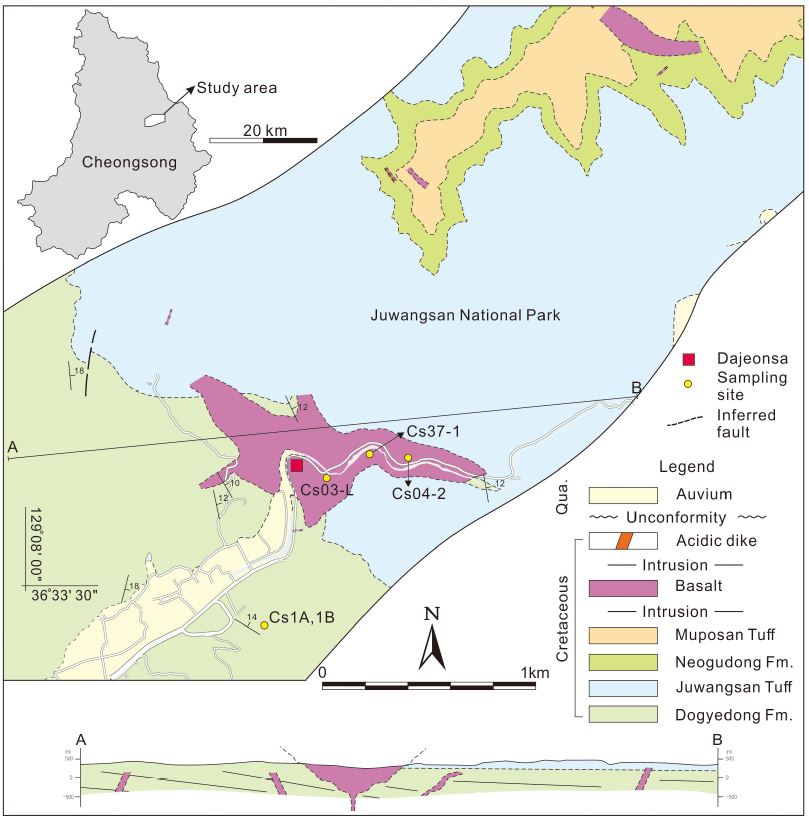
Geological map of the study area with sample locations. The basalt cutting the underlying sedimentary and volcanic rocks is interpreted as intrusive rock.
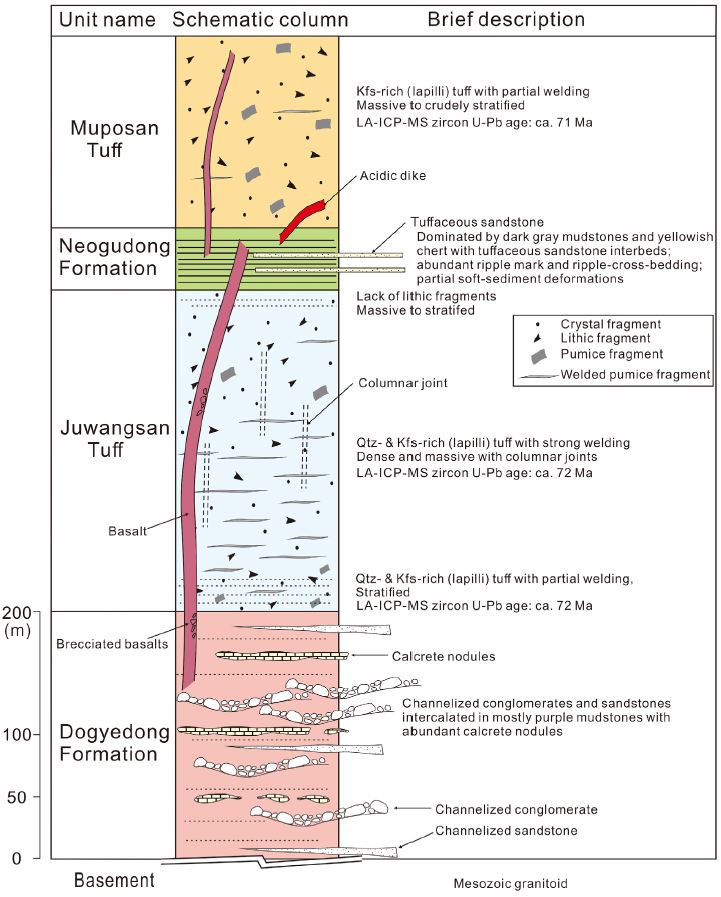
Schematic diagram of the study area with brief descriptions and inferred thickness of the lithological units.
주왕산응회암과 무포산응회암 사이에 분포하는 너구동층은 조사구역에서 고도 500 m 이상의 고지에 분포하고 있다(그림 1). 너구동층은 조사지역을 벗어난 북쪽지역인 월외리 너구동 주위에 넓게 분포하고 있으며, 최대 두께가 200 m에 달한다(Hwang, 1998). 이 층이 남쪽으로 얇게 연장되어 조사지역에는 약 30 m ~ 50 m 두께로 나타나며, 주로 이암과 처트(chert)로 구성되어 있으며 응회질 사암이 협재되어 있다(그림 2).
조사지역의 북쪽과 동쪽에 분포하는 무포산응회암은 조사구역 밖 남쪽의 주왕산 화산지역에서 가장 넓게 분포하고 있으며, 최대 두께가 약 500 m로 추정된다(Hwang and Kim, 2006). 이 응회암은 하위의 주왕산응회암에 비해 석영 결정편이 거의 없고 장석 반정이 우세하게 나타나며, 주로 괴상 내지 용결조직을 보이는 화산력 응회암으로 구성되어 있다(그림 2). 지화학 분석은 비알칼리 계열 중에 칼크-알칼리 계열의 유문데사이트질 내지 유문암질 영역에 도시된다(Hwang and Kim, 2006). 이 응회암의 Rb-Sr 전암동위원소 연령분석결과는 63.6±3.4 Ma (Hwang and Kim, 2006), LA-ICP-MS zircon U-Pb 연령은 약 71 Ma (Kwon et al., 2017)로 측정되었다. Ahn and Hwang (2007)은 응회암 내 부석편의 배열로부터 유상선구조(flow lineation)의 측정을 통해 무포산응회암의 화성쇄설물 공급지가 주왕산의 남동쪽에 위치하였을 것이라고 해석한 바 있다.
이번 연구 대상인 현무암(대전사현무암; Koh et al., 2000)은 도계동층과 주왕산응회암 사이에 분포하고 있으며(그림 1), 다수의 현무암질 용암이 중첩되어 형성된 것으로 보고되고 있다(Koh et al., 2000; Woo and Jang, 2014). 하지만 이번 야외지질조사결과 현무암이 도계동층, 주왕산응회암 그리고 무포산응회암을 다양한 층준에서 자르며 나타나고 있는 점, 용암류를 지시하는 구조(예, 유상구조, 밧줄구조, 클링커 등)가 나타나지 않는 점, 그리고 도계동층과 주왕사응회암 사이에 고립되어 나타나는 특징 등은 현무암이 용암류가 아닌 관입암으로 해석된다(그림 1, 2). 따라서 이 논문에서는 ‘대전사현무암’의 명칭을 사용하지 않고 현무암으로 명명하였다.
현무암의 관입경계는 상의탐방지원센터에서 대전사 사이에 위치한 주왕산꽃돌식당 아래 주방천의 절개지 그리고 주방계곡 등산로의 자하교 서편 주방천 하천바닥에서 잘 관찰할 수 있다(그림 3a, 3b). 현무암은 대전사 부근 그리고 조사구역의 북서쪽에 주로 분포하고 있으며, 그 외에도 너구동층과 무포산응회암 내에 단속적으로 분포한다(그림 1). 현무암은 전체적으로 암회색을 띠며, 야외에서 육안으로 사장석 반정이 관찰되는 반상조직 또는 반정이 관찰되지 않는 미정질 조직을 보인다. 주로 기공이 없이 치밀하지만(그림 3c), 부분적으로 다공질 조직을 보인다. 그리고 이 기공은 방해석, 석영, 아게이트, 녹염석 등과 같은 이차적인 광물로 채워져 행인상 구조를 보인다(Woo and Jang, 2014)(그림 3d). 대전사 부근 주방천 바닥과 일부 지역에는 현무암이 각력화 되어 있고 각력들 사이를 자색의 광맥이 충전하고 있다(그림 3e). Woo and Jang (2014)는 이러한 조직을 페퍼라이트로 해석한 바 있다. 현미경 하에서 현무암은 미정질의 사장석 래스(lath) 기질에 사장석과 감람석 반정이 관찰된다(그림 4a, 4b). 감람석 반정은 상당한 풍화와 변질작용을 받아 원래의 조직을 관찰하기 어렵다. 원형 또는 아메바 모양을 보이는 현무암의 기공은 이차적인 석영 및 방해석으로 채워져 있다(그림 4c, 4d, 4e, 4f).
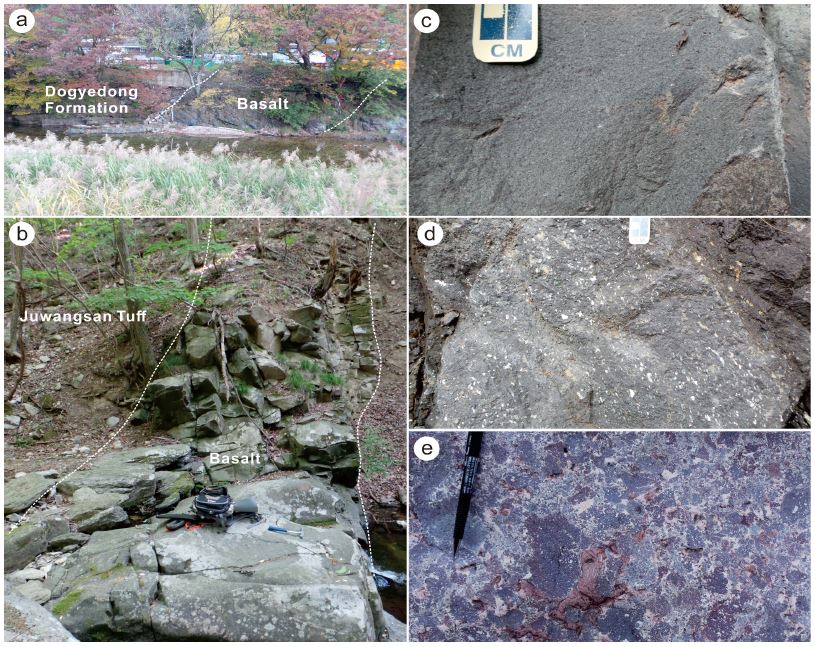
Outcrop photographs of the basalt. (a-b) The outcrops show the subvertical to vertical contacts between the underlying sedimentary and volcanic rocks and the basalt. (c) Close-up view of the basalt with dense and aphanitic texture. (d) Vesicles of the basalt are filled by secondary minerals, showing an amygdaloidal texture. (e) Close-up view of the brecciated basalt. The basalt fragments are surrounded by purple vein.
3. 연구 방법
각력화된 현무암과 그 내부를 채우고 있는 자색 광맥의 조직 그리고 이들의 성인을 파악하고자 전계방사형 주사전자현미경-에너지 분산형 분광기(SEM-EDS)와 X-선 회질분석기(XRD)를 이용하여 구성광물 및 조직을 관찰하였다. 시료는 자색 광맥이 잘 나타나는 세 곳(Cs03-L, Cs04-2, Cs37-1) 그리고 자색 광맥과 백악기 퇴적암과의 비교를 위해 도계동층 내 자색 이암 두 곳(Cs1A, Cs1B)에서 채취하였다(그림 1).
SEM 관찰을 위해 채취한 시료는 박편 및 연마편을 제작하였으며, 경상대학교 공동실험실습관이 보유중인 Jeol사의 JSM-7610F 모델의 전계방사형 주사전자현미경(FE-SEM)과 X-선 에너지 분광기(EDS)를 이용하여 조직관찰과 광맥동정을 실시하였다. 가속전압 15 kV, 가속전류 1 nA, 초점거리 15 mm 조건에서 영상관찰을 하였으며, 고배율(×10,000 이상) 영상촬영 시에는 가속전압 10 kV, 가속전류 0.5 nA, 초점거리 4.5 mm 조건에서 관찰하였다.
분말 제작된 시료는 경상대학교 공동실험실습관이 보유하고 있는 Bruker사의 D8 Advance A25 모델을 이용하여 X-선 회절분석을 실시하였다. 획득된 X-선 회절 자료는 EVA V3.1 (정성분석) 프로그램을 이용하여 광물 조성분석을 하였다. 분석조건은 니켈 필터를 이용한 구리 파장의 X-선을 이용하여 40 kV, 40 mA, 4~90° 2-theta 구간에서 0.02도/57.3초로 분석을 실시하였다.
4. 결 과
현미경하에서 도계동층의 자색 이암은 주로 석영과 장석 결정편으로 구성되어 있는 반면, 자색 광맥은 결정편이 없는 아주 균질한 형태를 보인다(그림 5a, 5b). 또한 후방산란전자영상(BEI)에서 자색 이암은 석영 및 흑운모의 결정형태가 관찰되는 반면, 자색 광맥은 반정이 나타나지 않고 균질해 보인다(그림 6a, 6b). 현무암은 주로 사장석과 감람석 반정 그리고 사장석 래스 기질로 이루어져 있다. 사장석은 뚜렷한 광물의 형태 및 가장자리를 보이나, 그 내부는 부분적으로 은미정질의 점토광물로 치환되어 있으며 그 결과 전반적으로 변질을 심하게 받은 상태이다(그림 6c, 6d). 자색 광맥은 현무암 내부로 주입된 형태를 보이고 있는데(그림 6c, 6d), 이 광맥 내에는 현무암에서 뜯겨 나온 사장석 반정이 고립되어 나타나기도 한다(그림 6d). 현무암과 광맥의 경계는 불규칙하며, 현무암의 가장자리에는 급격히 식어서 만들어지는 유리질 급냉대의 흔적을 찾아볼 수 없다(그림 6c, 6d). 광맥은 현무암과 달리 커다란 결정편은 나타나지 않으며, 주로 은미정질의 석영과 점토광물 그리고 소량의 적철석으로 구성되어 있다(그림 6e, 6f). 석영은 대부분 1 µm이하의 입자들이 연정을 이루고 있으며, 일반적인 석영과 같은 뚜렷한 결정형태를 보이지 않는다. 또한 석영입자 사이에 판상의 점토광물이 채우고 있는 형태를 보인다(그림 6f).
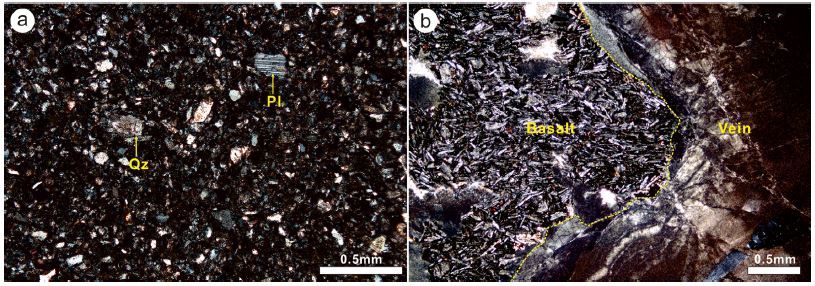
Microphotograph of the purple siltstone of the Dogyeodong Formation (a) and the purple vein (b) under crossed nicols. The siltstone consisting mostly of fragments of quartz (Qz) and plagioclase (Pl) crystals, whereas the vein showing lack of fragments of crystals. No glassy rim appears at the boundary between the basalt and vein.
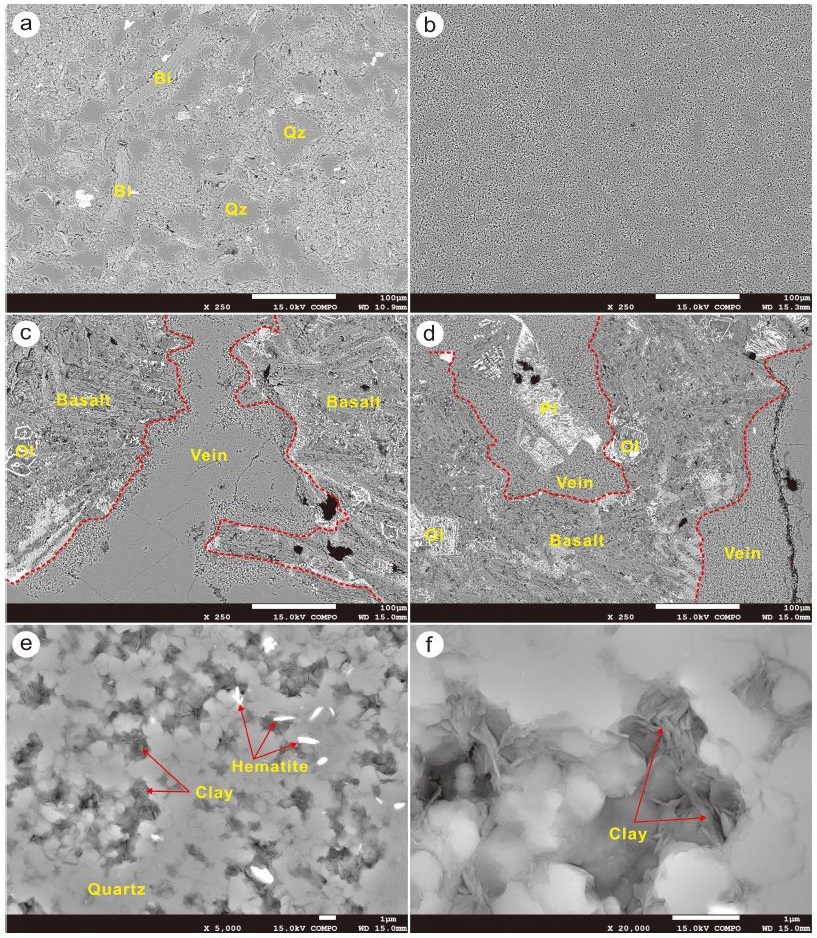
BEI image of purple siltstone of the Dogyedong Formation and the vein. (a) The siltstone containing fragments of quartz (Qz) and biotite (Bi) crystals, showing hetrogeneous feature. (b) The vein consisting of cryptocrystallined quartz, showing homogeneous feature. (c-d) The irregular contact between the basalt fragments and the vein without glassy rim along the contact. The vein including plagioclase (Pl) fragments, which were derived from the basalt. (e-f) Close-up view of the vein, consisting of quartz (Qz), clay minerals and hematite. The sheet-shaped clay minerals are mainly distributed between quartz particles.
X-선 회절분석 결과, 자색 이암(Cs1A, Cs1B)과 현무암 내 자색 광맥(Cs04-2, Cs37-1, Cs03-L)은 공통적으로 석영, 스멕타이트-일라이트 혼합층, 적철석 등의 광물들로 구성되어 있으나, 자색 이암에만 사장석과 비교적 결정도가 높은 일라이트가 포함되어 있다(그림 7). 특히, 자색 광맥은 거의 대부분 석영으로만 이루어져 있어 자색 이암에 비해 비교적 단순한 회절패턴을 보이는 것이 특징이다. 일부 자색 광맥(Cs37-1) 내에는 소량의 사장석이 포함되어 있기도 한다(그림 7). 이러한 특징은 자색 이암과 현무암 내 자색 광맥이 서로 다른 공급지에서 기원하였음을 지시한다.
5. 토의: 유사 페퍼라이트 형성 기작
뜨거운 용암 또는 지하천부를 관입한 마그마가 물을 포함하고 있는 미고화 퇴적물을 만나게 되면, 퇴적물 속의 수분이 급격히 끓어오르고 부피가 팽창하면서 퇴적물의 유동(fluidization)이 일어나고 용암 또는 마그마는 수증기성 폭발(steam explosion)과 급냉-파편화작용(quenching fragmentation)에 의해 페퍼라이트가 형성된다(Skilling et al., 2002, and references therein). 이러한 페퍼라이트의 존재 여부 및 산출 위치는 마그마의 정치과정(용암류 또는 관입) 그리고 생성 당시의 지표 및 지하 환경을 이해하고 해석하는데 중요한 의미를 지닌다(Byerly and Swanson, 1978; Beresford et al., 2000; Waichel et al., 2006). 야외에서 화성쇄설물과 퇴적물이 이차적인 퇴적작용에 의해 뒤섞이게 되면 페퍼라이트와 유사한 형태를 만들기도 하며, 이를 페퍼라이트형 각력암 또는 유사 페퍼라이트(pesudo-peperite or pe-perite-like)라고 한다(Jerram and Stollhofen, 2002; Skilling et al., 2002; Petry et al., 2007; Waichel et al., 2008). 따라서 페퍼라이트와 유사한 조직 및 구조를 보이는 암체에 대해 외형적으로만 판단할 경우 잘못된 해석을 할 수 있기 때문에 성인에 대한 해석이 반드시 선행되어야 한다(e.g., Branney and Suthren, 1988; Jerram and Stollhofen, 2002; Petry et al., 2007; Waichel et al., 2008).
우리나라에서 연구된 페퍼라이트는 전북 부안군 적벽강(Kim, 2000; Choi et al., 2001; Ghim and Kwon, 2017)과 모항해수욕장(Kwon and Ghim, 2017), 대구 지역에 분포하는 학봉현무암 그리고 고령과 합천지역에 분포하는 청룡사현무암에서 보고되고 있다(Jeon, 2009). 이들 지역은 용암류(적벽강, 학봉현무암, 청룡사현무암)와 퇴적암 또는 중성 암맥과 화성쇄설암(모항해수욕장)과의 경계부를 따라 두 암석이 뒤섞여 나타나고 있어 야외에서 쉽게 페퍼라이트로 인지된다. 특히 적벽강과 모항해수욕장은 전북서해안권 국가지질공원 지질명소로 지정되어 일반인들에게 페퍼라이트의 형성기작에 대해 지질교육 및 관광자원으로 활용되고 있다. 하지만 연구지역의 현무암 내 페퍼라이트 조직(Woo and Jang, 2014)은 현무암과 자색 이암의 경계부가 아닌 현무암(관입암) 내에 산출되고 있어, 두 암석의 경계부를 따라 산출되는 페퍼라이트의 일반적인 특징(SKilling et al., 2002, and references therein)과 다르다. 만약 현무암이 관입하는 동안 하위의 자색 이암을 포획암으로 뜯어오고 이들이 운반되는 과정에서 뒤섞여 현재의 페퍼라이트 조직을 만들 수도 있다. 하지만 최근 White et al. (2000, 2006)은 페퍼라이트를 마그마가 물을 머금은 퇴적물과 제자리(in situ)에서 각력화되고 뒤섞여 만들어 진 것으로 정의하고 있다. 따라서 자색 이암이 현무암 내에서 포획암처럼 뜯겨 와서 페퍼라이트 조직을 만들 수는 있다 하더라도 고화되지 않은 상태에서 형성된 것이 아니고 운반되었기 때문에 페퍼라이트로 간주할 수는 없다.
Woo and Jang (2014)은 페퍼라이트가 현무암과 퇴적암의 직접적인 경계부에 나타나지 않는 것에 대해 현무암질 용암류의 휴지기 때 용암류 사이에 쌓인 퇴적물과 이후 용암류가 뒤섞여 페퍼라이트가 만들어진 것으로 해석한바 있다. 하지만 현무암은 야외에서 지표를 흐른 용암류를 지시하는 구조가 나타나지 않고, 시기를 달리하는 도계동층과 주왕산화산암을 동시에 자르고 있어 관입에 의해 형성된 것으로 판단된다. 또한 현무암 용암류 단위 사이에 페퍼라이트를 만들었다고 추정되는 퇴적암이 노두로 존재하지 않아 용암류가 흐를 당시 협재된 퇴적물과 섞이면서 페퍼라이트가 형성되었다고 해석(Woo and Jang, 2014)하기에는 무리가 있다.
일반적으로 페퍼라이트 형성 시, 퇴적물은 유체화작용으로 인해 내부 층리가 파괴되거나 교란되고 마그마 기원의 암편들은 가장자리에 유리질 급냉대 또는 열변질대가 잘 나타난다(Skilling et al., 2002, and references therein). 하지만 조사지역 현무암의 가장자리에는 유리질 급냉대 또는 열변질대 흔적이 없고 자색 광맥을 구성하고 있는 은미정질 석영 및 점토광물에 아무런 교란흔적이 나타나지 않고 균질한 특징은 일반적인 페퍼라이트 형태와는 매우 다른 특징을 보인다. 반면 관입암 내부의 광맥은 마그마의 일차적인 정치작용에 의해 만들어지기 어렵고 이차적으로 만들어진 파쇄대를 광물들이 충전한 것으로 판단된다. 따라서 광맥이 현무암을 울퉁불퉁하게 자르고 있는 점 그리고 광맥 내부에 현무암에서 뜯겨나온 결정편을 포함하고 있는 특징은 현무암 내부로 유체가 침투하면서 각력화시키고, 이 과정에서 현무암의 결정편들이 광맥 내부로 뜯겨져 이동한 것으로 보인다. 또한 현무암의 가장자리가 너들너들하고 불규칙한 형태는 오랜 기간 동안의 운반 또는 재동 작용을 받을 경우에는 이들의 형태가 보존되지 않기 때문에, 이러한 가장자리 특성은 제자리에서 각력화시켜 퇴적공간을 만들고 그 사이를 유체에 운반되던 광물들이 빠르게 채웠음을 지시한다. 따라서 청송 유네스코 세계지질공원의 주방천 페퍼라이트(Woo and Jang, 2014)는 유체가 현무암 내부로 주입되어 수압파쇄(hydrofracture; Philipp et al., 2013)가 일어났고, 그 틈을 따라 광물들이 성장하여 만들어진 2차 구조로 해석된다. 더하여 철산화작용으로 적철석이 형성되면서 광맥은 야외에서 붉은 색을 띠는 것으로 해석된다.
6. 결 론
청송 유네스코 세계지질공원 지질명소 중 하나인 주방천 페퍼라이트(Woo and Jang, 2014)는 현무암질 용암과 자색 이암이 뒤섞여 만들어졌으며, 이러한 정치작용은 퇴적 동시성 화성활동의 주요한 사례로 지질공원 교육에 활용되고 있다. 하지만 이번 야외지질조사결과, 현무암은 하위의 화산암(주왕산응회암과 무포산응회암)과 퇴적암(너구동층)을 다양한 층준에서 자르며 나타나는 관입암으로 해석되며, 퇴적암과의 경계부가 아닌 관입암(현무암) 내에 나타나는 페퍼라이트 조직은 일반적인 페퍼라이트 조직과 일치하지 않는다. 자색 광맥과 접하는 현무암의 가장자리에 유리질 급냉대 흔적이 없는 점, 광맥 내부에 층리의 교란 작용이 나타나지 않는 점, 현무암의 가장자리가 울퉁불퉁 한 점 그리고 광맥 내부에 현무암에서 뜯겨온 결정편을 포함하고 있는 점 등의 특징은 퇴적동시성 화성활동보다는 현무암 형성 이후에 주입된 이차적인 유체에 의해 현무암이 제자리에서 각력화되고 그 틈을 따라 석영이 충전하였음을 지시한다. 이는 주방천 페퍼라이트가 퇴적동시성 화산활동에 의해 형성된 것이 아니라 이차적인 유체의 수압파쇄에 의해 만들어진 페퍼라이트형 각력암 또는 유사 페퍼라이트로 해석된다. 이번 연구결과를 바탕으로 청송군은 세계지질공원 지질명소에 대한 교육자료 및 관광자원에 대해 보완해야 할 것으로 판단된다.
Acknowledgments
이 연구는 청송군청의 지원을 받아 수행한 한국지질자원연구원 수탁사업인 ‘청송국가지질공원 지질명소 내 화산암류 기초지질조사·연구사업’과 과학기술정보통신부 지원을 받아 시행한 한국지질자원연구원의 주요사업인 ‘디지털매핑에 의한 통합 지질정보 제공기술 개발(GP2017-002)’의 일환으로 수행되었다. 본 논문에 건설적인 조언을 해주신 제주특별자치도 세계유산본부 한라산연구부 전용문박사님과 익명의 심사자분께 감사드립니다.
References
- Ahn, U.S., and Hwang, S.K., (2007), Determination of flow direction from indicators in the Muposan Tuff, southern and eastern Chenongsong, Korea, Journal of the Economic and Environmental Geology of Korea, 42, p253-271, (in Korean with English abstract).
-
Beresford, S.W., Cas, R.A.F., Lambert, D.D., and Stone, W.E., (2000), Vesicles in thick komatiite lava flows, Kambalda, Western Australia, Journal of the Geological Society, London, 157, p11-14.
[https://doi.org/10.1144/jgs.157.1.11]

- Branney, M.J., and Suthren, R.J., (1988), High-level peperitic sills in the English Lake District: Distinction from block lavas, and implications for Borrowdale Volcanic Group stratigraphy, Geological Journal, 23, p171-187.
- Byerly, G., and Swanson, D., (1978), Invasive Columbia River basalt flows along the northwestern margin of the Columbia plateau, northcentral Washington, Geological Society of America Bulletin, 10, p98.
- Choi, S.W., Lee, Y.E., Park, K.H., and Lee, C.H., (2001), Occurrence and formation model of peperite in the Jugmagri area, Byeonsan Peninsula, Korea, Journal of the Geological Society of Korea, 37, p197-308, (in Korean with English abstract).
- Ghim, Y.S., and Kwon, C.W., (2017), Textural variations and fragmentation processes in peperite formed between felsic lava flow and wet substrate: an example from the Cretaceous Buan Volcanics, southwest Korea, Journal of Volcanology and Geothermal Research, 331, p92-101.
- Hwang, S.K., (1998), Volcanic geology in the Cheongsong area, '98 Spring Geological Field Excursion of the Geological Society of Korea, p40, (in Korean).
-
Hwang, S.K., (2014), Welding and textural evolution in the Juwangsan Tuff in Cheongsong, Korea, Journal of the Geological Society of Korea, 50, p475-488, (in Korean with English abstract).
[https://doi.org/10.14770/jgsk.2014.50.4.475]

- Hwang, S.K., Kang, G.H., and Jo, H.R., (2015), Development of additional geosites in Cheongsong National Geopark and supplementation of the conditions for accrediation, Cheongsonggun, p215, (in Korean).
- Hwang, S.K., and Kim, S.H., (2006), Magmatic processes of the Muposan Tuff, Southern and Eastern Cheongsong, Korea, Journal of the Geological Society of Korea, 42, p253-271, (in Korean with English abstract).
- Hwang, S.K., and Kim, J.H., (2009), Topographical landscapes and their controlling geological factors in the Juwangsan National Park: Welding facies and columnar joints, Journal of the Petrological Society of Korea, 18, p195-209, (in Korean with English abstract).
- Hwang, S.K., Lee, B.J., and Reeman, A.J., (2007), Magmatic processes of the Juwangsang Tuff, southeastern Cheongsong, Journal of the Geological Society of Korea, 43, p65-81, (in Korean with English abstract).
-
Jerram, D., and Stollhofen, H., (2002), Lava-sediment interaction in desert settings; are all peperite-like textures the result of magma-water interaction?, In: Processes and Products of Magma-Sediment Mingling Journal of Volcanology and Geothermal Research, 114, p231-249.
[https://doi.org/10.1016/s0377-0273(01)00279-7]

- Jeon, Y.M., (2009), Lithofacies and emplacement processes of the volcanogenic rocks in the Cretaceous Gyeongsang Basin and Quaternary Jeju Island, Korea, Phd Thesis, Gyeongsang National University, Jinju, Korea, p165.
- Kim, S.B., (2000), Sedimentary processes and environments of the Kyokpori Formation (Cretaceous), SW Korea, PhD Thesis, Seoul National University, Seoul, Korea, p200.
- Kim, S.W., and Park, B.S., (1970), Explanatory text of the Geological map of Yongyang sheet, Geological Survey of Korea, p25, (in Korean with English abstract).
- Koh, J.-S., Ahn, J.-Y., and Yun, S.-H., (2000), Petrological characteristics of the Daejeonsa Basalt in the Mt. Juwang area, Cheoongsong-gun, Gyeongsang buk-do, Korea, Journal of the Korean Earth Science Society, 21, p553-562, (in Korean with English abstract).
- Kwon, C.W., and Ghim, Y.S., (2017), Effect of host sediment fluidization on peperite texture: Tuff-hosted peperites in the Buan Volcanics, Korea, Journal of Volcanology and Geothermal Research, 341, p84-93.
- Kwon, C.W., Gihm, Y.S., Lee, S.B., Cho, D.R., and Hong, P., (2017), Survey of volcanics in the geosites of Chengsong National Geopark area, Korea Institute of Geoscience and Mineral Resources, p74, (in Korean).
-
Petry, K., Jerram, D.A., Almeida, D.P.M., and Zerfass, H., (2007), Volcanic-sedimentary features in the Serra Geral Fm., Paraná Basin, southern Brazil: Example of dynamic lava–.sediment interactions in a arid setting, Journal of Volcanology and Geothermal Research, 159, p313-325.
[https://doi.org/10.1016/j.jvolgeores.2006.06.017]

-
Philipp, S.L., Afşar, F., and Gudmundsson, A., (2013), Effects of mechanical layering on hydrofracture emplacement and fluid transport in reservoirs, Frontiers in Earth Science, 1, p1-19.
[https://doi.org/10.3389/feart.2013.00004]

-
Skilling, I.P., White, J.D.L., and McPhie, J., (2002), Peperite: a review of magma-sediment mingling, In: Skilling, I.P., White, J.D.L., and McPhie, J. (Eds), Peperite: Processes and Products of Magma-Sediment Mingling Journal of Volcanology and Geothermal Research, 114, p1-17.
[https://doi.org/10.1016/s0377-0273(01)00278-5]

- Waichel, B.L., de Lima, E.F., Sommer, C.A., and Lubachesky, R., (2006), Peperite formed by lava flows over sediments: an example from the central Parana Continental Flood Basalts, Brazil, Journal of Volcanology and Geothermal Research, 159, p343-354.
-
Waichel, B.L., Scherer, C.M.S., and Frank, H.T., (2008), Basaltic lava flows covering active aeolian dunes in the Paraná Basin in southern Brazil: Features and emplacement aspects, Journal of Volcanology and Geothermal Research, 171, p59-72.
[https://doi.org/10.1016/j.jvolgeores.2007.11.004]

-
White, J.D.L., and Houghton, B.F., (2006), Primary volcaniclastic rocks, Geology, 34, p677-680.
[https://doi.org/10.1130/g22346.1]

-
White, J.D.L., McPhie, J., and Skilling, I., (2000), Peperite: a useful genetic term, Bulletin of Volcanology, 62, p65-66.
[https://doi.org/10.1007/s004450050293]

-
Woo, H.D., and Jang, Y.D., (2014), Occurrence and morphological characteristics of the peperite in Mt. Juwang, Cheongsong, Economic and Envrionmental Geology, 47, p97-105, (in Korean with English abstract).
[https://doi.org/10.9719/eeg.2014.47.2.97]


